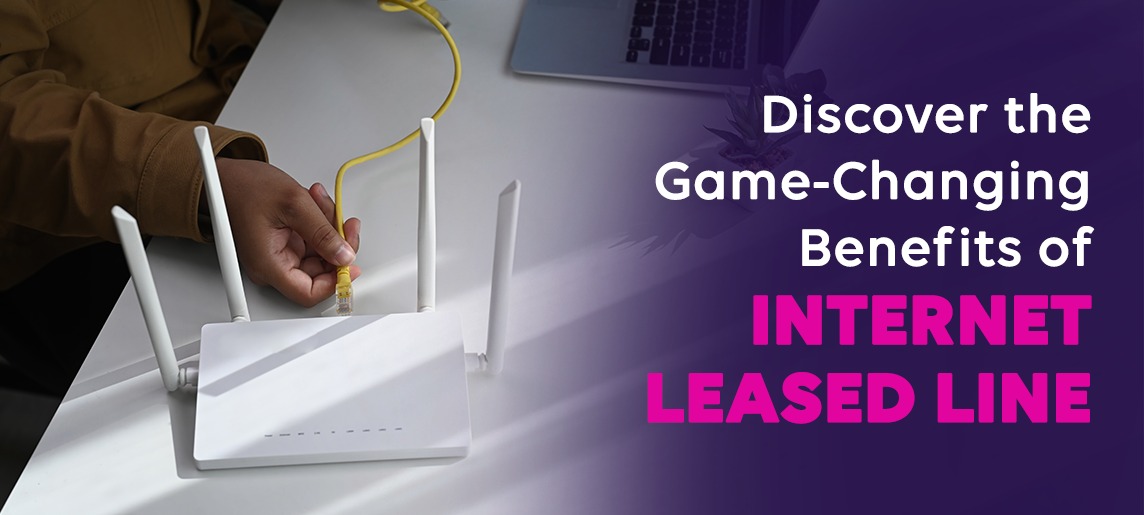In today's hyperconnected world, reliable Internet access has become an essential lifeline. Whether streaming series/movies, video conferencing with colleagues, or scrolling down social media feeds, a robust Internet connection drives modern lives.
A report reveals that almost half of India’s population – 759 million - are active Internet users. The figure will likely reach 900 million by 2025.
However, the rapid Internet penetration may bombard your brain with more questions than answers, especially when comparing wired vs. wireless Internet. Each broadband technology boasts its own set of pros and cons, leaving you grappling with the decision: to plug in or unplug?
No doubt, the wired Internet connection is the go-to network option for corporate environments. That said, the evolution and large-scale proliferation of LTE/5G has seen wireless networks playing a bigger role in organizations worldwide, with many C-level executives rethinking their options.
So, how do wired and wireless Internet stack up against each other? Let’s find out.
Wired Broadband Connectivity
Wired broadband offers Internet access through physical cables, usually copper, fiber-optic, or coaxial cables. It carries various electrical signals from one endpoint to another. Most wired broadband connections involve the Internet flowing simultaneously from a cable modem or a T1 line to multiple devices.
Types of Wired Internet (DSL, Cable, Fiber Optic)
Ethernet
Ethernet connections use Ethernet cables (usually made of copper) to connect web-browsing devices directly to a router or modem. This type of wired Internet connection is common in local area networks (LAN) within offices, homes, or other localized environments.
Fiber Optic
Fiber-optic broadband uses optical fibers made of thin strands of glass or plastic to transfer data using light pulses. It offers exceptionally high Internet speeds (up to gigabits) and low latency.
Digital Subscriber Line (DSL)
DSL uses existing copper phone lines to deliver Internet access, making it widely available even in rural regions. While not as fast as Ethernet and fiber, this wired broadband connection is still adequate for basic browsing and email conversations.
Broadband over Power Lines (BPL)
BPL transmits data over existing electrical power lines. It is also called Power Line Communication (PLC) and Internet over Power Line (IPL). BPL operates similarly to DSL, using power lines instead of phone lines. While less popular than other types, it offers an alternative for areas where traditional wired broadband options could be challenging to deploy.
Cable
Cable broadband uses the same coaxial cables that transmit cable television signals to deliver Internet. These wired broadband Internet connections use cables with a core conductor and outer shielding, offering solid resistance to interference. It is widely available in urban and suburban areas and provides faster speeds than DSL, but not as fast as fiber optic.
Leased Lines
This dedicated, high-bandwidth, point-to-point connection is primarily commonplace in organizations with critical data needs, including video conferencing and cloud computing. Leased lines offer guaranteed speeds, uptime, and security.
Advantages
Reliability and Stability
Wired broadband directly (and physically) links your device with the Internet. Once the ISP properly sets up Ethernet cables, switches, and hubs, the result is a tremendously reliable system.
Besides, wired Internet cables are engineered to withstand radio frequencies and electromagnetic fields, leading to almost interference-free signals. They are more resistant to temperature and weather changes than traditional coaxial cables.
Consistent Speeds
Wired broadband connections are well-known for their fast data transfer speeds. With advancements in Ethernet, the speeds have been improving as Gigabit routers became commonplace. This makes wired networks ideal for high-bandwidth use cases, including online gaming and streaming media.
Moreover, a separate ethernet cable connects each of the Internet-connected devices directly to the network. As such, you will not slip into connectivity issues, such as dead spots.
Lower Latency
Wired Internet connections have considerably lower latency than their wireless counterparts, meaning you will experience less lag or delay during online interactions. This is critical for tasks including video conferencing, watching high-resolution videos, and real-time collaboration.
Solid Security
Wired broadband connections are less prone to cyber threats as they need physical access to the network. The physical cable builds a closed circuit that makes it more challenging for potential hackers to break into your system. This is particularly crucial if your job involves handling mission-critical data.
When installed with adequate security protocols, a wired Internet connection is well protected from unauthorized access. As long as your system network undergoes monitoring for any suspicious activity and all the ports are activated correctly, a wired broadband network is pretty safe to use.
Cost-Effectiveness
While the initial setup cost of running Ethernet cables could go slightly higher, wired broadband plans are often cheaper than wireless in the long run. Plus, the hardware used for these networks has a good lifespan, so you will not need to worry about replacing or upgrading them frequently.
Disadvantages
Installation Challenges
Setting up wired Internet connections is time-consuming, particularly in pre-existing buildings, as every device must be connected to the network. The process involves drilling holes, routing cables through walls and ceilings, and configuring firewalls and security applications. All of these take significant time.
Minimum Mobility
Needless to say, the limited mobility of wired broadband Internet connections is a big headache for users. Your access is restricted to wherever there is a port and cable available. If you want to use your device in another location, you must run additional wires and install switches to remain online. This hinders your collaboration with managers and team members.
Maintenance Issues
You may not need a server if you are deploying a small wired framework. However, adding more devices or users to the network will require a server to handle storage, workload, and capacity.
To fix issues with a wired broadband network, your IT staff must first identify which routers, wires, or devices are the real culprits before they can start troubleshooting. This adds to maintenance costs and downtime.
Wireless Broadband Connectivity
A home wireless Internet is a high-speed broadband that comprises electromagnetic waves (EM) or infrared (IR) waves. It eliminates the need for physical wires, enabling users to access the Internet via a radio frequency (RF) link. All wireless network devices will have antennae or sensors and do not use wires for voice or data communication.
Types of Wireless Internet
Wireless Fidelity (Wi-Fi)
Wi-Fi is one of the most prevalent wireless network technologies, connecting devices to the internet via radio waves within a local area network (LAN). It is commonly used in homes, offices, and public spaces, providing widespread access. Wi-Fi operates based on the IEEE 802.11 protocol family.
Cellular Broadband
Cellular broadband involves a telecom company providing consumers with high-speed Internet (3G, 4G, and 5G). The data is transmitted and received by a base station, which transmits the data wirelessly directly to the users’ devices, including smartphones and tablets.
Satellite
Satellite Internet transmits data between a satellite dish installed at the user’s location and a geostationary satellite orbiting Earth. It is particularly beneficial in remote or rural areas and is immune to terrain or infrastructure limitations.
Wireless Personal Area Networks (WPAN)
WPANs connect devices within an area within one person’s arm’s reach, making them suitable for small spaces like rooms or work desks. These wireless Internet connections use Zigbee or Bluetooth to link devices wirelessly near one central location. Their range can extend up to 10 meters.
Wireless Local Area Networks (WLAN)
WLANs use Wi-Fi technology to connect devices within a localized area, such as schools, airports, and offices. They use radio waves instead of Bluetooth for wireless Internet communication between devices.
The key components of WLANs include wireless routers or access points that facilitate communication between devices and wireless network interface cards (NICs) integrated into any Internet-connected devices.
Wireless Metropolitan Area Networks (WMAN)
WMANs use Worldwide Interoperability for Microwave Access (WiMAX) to deliver Internet over an entire metropolitan area or city. They use a point-to-multipoint architecture, where a base station communicates with multiple subscriber stations within its coverage area.
Wireless Wide Area Networks (WWAN)
WWANs cover large geographical areas, such as cities or even countries, via multiple satellite systems, mobile phone signals, or antenna sites managed by ISPs. These wireless networks enable users to stay connected to the Internet in regions where wired infrastructure is difficult to install.
Fixed Wireless Access (FWA)
FWA uses point-to-point or point-to-multipoint wireless links for Internet delivery. It provides wireless Internet between two fixed points through 4G and 5G radio spectrum. Additionally, it requires line-of-sight installation between towers and users' device antennas.
Advantages
Easy Setup and Maintenance
No drilling holes or running cables through walls! Wireless Internet connection installs are a breeze, with only a router setup and device connections. You do not need extensive circuitry when you are scaling up. As a sweetener, home wireless Internet demands straightforward maintenance as most of the job is based on software instead of hardware. This makes it ideal for start-ups and home users (renters and students).
Hyper-mobility
Mobile to all levels. The freedom to roam around your home or workplace while staying online is an incredible advantage of wireless networks. This type of connectivity frees you from the shackles of cables tethered to a specific physical point. You can, for instance, take your device into the conference room and access or download business-critical resources within the network coverage zone.
Access Anywhere
When on the go, public Wi-Fi hotspots in libraries, cafes, and even railway stations become your playground. Wireless Internet lets you enjoy working online almost anywhere, making it perfect for remote workers and travel enthusiasts.
No Cable Clutters
Plain and straightforward, wireless Internet connections require fewer cables and wall jacks. As such, your home or office looks more organized and aesthetically pleasing. While it may not be big a deal, it is especially valuable in small apartments or minimalist design spaces.
Disadvantages
Network Congestion
In densely populated areas or locations with numerous Wi-Fi networks sharing the same frequency, you may experience network congestion. As such, your Internet speed drops substantially, resulting in signal degradation, reduced throughput, or even complete loss of connectivity.
Inconsistent Speed
Compared to wired broadband, wireless networks experience fluctuations in speed and performance due to interference from walls, appliances, and other Wi-Fi networks. Moreover, the signal strength varies if you keep changing your location frequently. This can be frustrating for high-bandwidth tasks, including streaming 4K content, downloading large files, or having high-quality video calls.
Security Concerns
Wireless connections, especially those with no two- or multi-factor authentications in place, are less secure than wired as communication and data signals flow through open air via radio waves. So, they are interceptable from threat actors if there are no proper security measures in the first place.
Which One Is Right For You: Wired or Wireless Broadband Connectivity?
In the end, there is no clear-cut winner in the “wired vs. wireless Internet” face-off as every business has its own requirements. Factors such as plan price, security protocols, workforce size, and location, all contribute to this decision.
In broad strokes, wired broadband is more robust and secure and does not put a hole in your pocket. So, for instance, if you work in a bank or the stock market, a wired broadband connection would be your best bet. That is because the kind of data and digital transactions these financial institutions handle are considerably critical and require fast data transfer speeds.
On the flip side, wireless Internet is costlier yet miles ahead in terms of flexibility and convenience. So, if you work for a digital marketing company that requires employees to roam around a lot to collaborate, you will need the flexibility that wireless offers.
Nevertheless, as long as you know your needs, you can pick the most suitable broadband solution without worrying about the marketing chaff around it.





 By Rahul Nambiar | 27th March 2024
By Rahul Nambiar | 27th March 2024

 By Rahul Nambiar | 19th March 2024
By Rahul Nambiar | 19th March 2024
 By Rahul Nambiar | 25th January 2024
By Rahul Nambiar | 25th January 2024